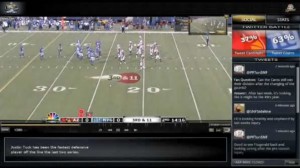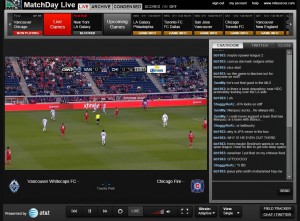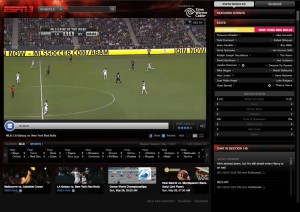Sports are the Porn of Television -or- How Networks Might Be Testing the Waters for Internet-Enabled TVs (if they’re smart)
So I’m watching the MLS MatchDay Live free preview weekend, bored to tears by the Chicago Fire taking on a fledgling Vancouver Whitecaps (in NFL terms, like if the Vikings took on Carolina — yeah, that messy) while missing a blacked out Galaxy/Red Bulls game and can’t help to pay attention to Silverlight-based application I’m using. You see, I’m watching the game on my computer, as I’ve done for many a sports broadcast over the past year or so. Along with this I’ve also enjoyed some Premier League and Serie A soccer on ESPN3 and the NFL on NBC’s Sunday Night Football application.
ESPN has been on the front lines for the industry in terms of technology, first pushing high-definition along with The Discovery Channel (and, arguably, selling the nation on its value) and, now, being on of the first cable networks to offer 3D (no matter how completely ridiculous you think it is for entertainment to sink its money into that pit). Naturally, their ESPN3 nee ESPN360 was one of the first serious internet-based sports viewing applications. As other networks pick up on the trend, and internet-enabled televisions pick up some steam in the marketplace (makes more sense than having to put on battery-powered glasses everytime you want to watch TV), I can see how this could be a testing ground for the grand assimilation of internet and old(er) media. It’s like TV is giving internet a drawer, maybe a key, that could lead to moving in together before eventual marriage.
Other TV streaming options like Hulu or Netflix are great for recorded television but live television is a different animal, especially since it’s a goldmine for data. Gauging audience participation during a live (or first-run) event using the power of the internet? Being able to create your own application for your channel to offer audiences extras and options and your advertisers real-time data and interactivity for promotions? Why wouldn’t you want to do this?
Sports, as a genre with ample live value and strong audiences, is a natural fit for testing the waters in a new manipulation of the medium and the applications are getting stronger. But what’s good and bad about them so far?
The applications we’ll look at are ESPN3, MLS MatchDay Live (which uses broadcasts from Fox Soccer Channel and Comcast Sports), and Sunday Night Football Extra (the weekly companion to the NBC’s game of the week). It’s worth noting their levels of access. MatchDay Live is a pay model when you can buy a season of MLS for around $60 (similar to the DirecTV sports packages like NFL Sunday Ticket). ESPN3 is accessible to cable customers that subscribe to an ESPN sports package (you can log in via your cable provider user name and password). NBC Sunday Night Football Extra (SNFX) is free to anyone that wants to watch. You could imagine that the different levels of access would allow different sets of features.
Let’s talk about the basic setup for these applications. Each is based in Flash or Silverlight, differentiating themselves from just streamed video embedded into an HTML page (like Hulu for example). It seems ultimately important that these are pop-out viewing ports separate from the rest of the site and that all the elements of the application are tightly integrated. All three applications feature a main window in which the game is streamed with basic controls familiar to anyone with a DVR: pause, skip back, skip ahead (in case you paused and have some game buffered), and a LIVE button (to get you immediately back to the action). Volume control and Full Screen options are also available. All three cut away from the main feed during commercial breaks either to show a “We’ll Be Back Shortly” message or show advertisements sold specifically for the internet ad space. All three offer varying quality of video based on your internet connection and some degree of interactivity.
Along with information you get from the broadcast feed (commentary, stats, scores, updates), the application also offer real-time statistic updates. Rather than waiting for lower-third graphics for updates on yardage, penalties, shots, etc, there is a tab the opens up (resizing your viewing port slightly) to show updating statistics.
In all three, there is also a real-time chat option in the form of a chatroom (MatchDay/ESPN3), Twitter feed (MatchDay/SNFX), or Facebook (ESPN3). SNFX’s Twitter feed, however, is highly moderated (the only way you can get a message through is to be retweeted either by the SNFX main account or by their online commentator, Mike Florio, who answers questions throughout the broadcast). MatchDay Live’s Twitter feed seems to be a collection of lightly-moderated hash-tag feeds while ESPN’s chatroom is exactly as you’d expect: neutered.
So the basics of an internet-enabled sports feed (viewport, video controls, real-time stats, and chat element) are similar across the board. What differentiates them are their extra features.
ESPN3 holds the biggest advantage since it has the widest swath of broadcast to choose from. Tired of the soccer game you’re watching? See if there are any late baseball games still on. What something different? Aussie Rules Football is available (and, seriously, that is different — cricket makes more sense). ESPN3 also has scorelines for many sports that live-update built into the application.
MatchDay Live also has a game switcher, though only between MLS games. Like ESPN3, you can also choose archived game, going back to even last season. Also like ESPN3, you have the option of a “mosaic” view where you can split the screen up into multiple games. Beyond that, the MatchDay Live application isn’t particularly robust, especially for being the only one on the subscription model. It has a field-tracker so you can see where penalties, shots, and goals occur on the field but that’s a tool that’s really only helpful in soccer so it wouldn’t fit in the ESPN3 model (which covers a great many sports) nor the SNFX (which only covers American football). It’s sort of a plain jane.

Twitter Battle is another feature of SNFX but in that way that yellow jugs offer the special feature of the fridge light not zapping essential nutrients from milk. Nobody cares, Scottie Mayfield. Nobody cares.
SNFX, on the other hand, is the most robust of the three (interestingly since it’s ad-supported). Where it lacks in its chat-fuction and an archive of games (NFL keeps a tight leash on that content), it more than makes up for in watching the game from different camera angles and being privy to injury- and team-related news before they’re reported in the telecast. Direct access to one of NBC’s game experts (Mike Florio) is also not a bad feature, as he not only discusses what’s happening in the current game but also anything going on in the league with his own brand of snark, answering viewer-tweeted questions.
Despite the repetitive commercials (I’m guessing networks have a hard time convincing advertisers to jump on since I see the same stupid ad demonstrating that Microsoft has no idea what “the cloud” is two or three times a break), all offer a pretty decent user interface and make watching the games enjoyable. I can only imagine that, as more people cut the cords or the internet-enabled television market expands, these applications will get better. Right now, there isn’t a whole lot of overlap as none of these networks have licenses to the same content but, as the dinosaurs of broadcast start to hop on board, and these kinds of applications develop from event presentations to something more commonplace, it’s going to come down to who has the killer features, whether it’s bonus content (like SNFX and their multiple camera angles) or synergistic access to a range of content (like ESPN3). The ability to hyper-brand a station and use the access to calculate real-time statistics seems like too juicy a carrot for networks not to chase. Porn is usually the way new technology is first monetized but, in this case, let sports be your porn.



